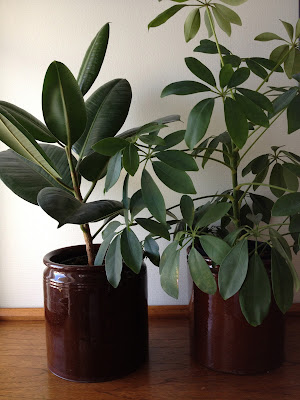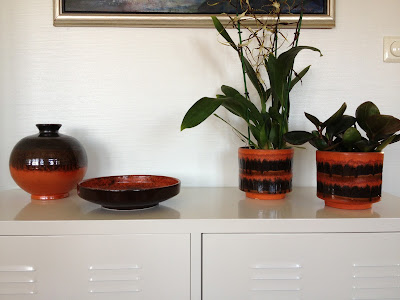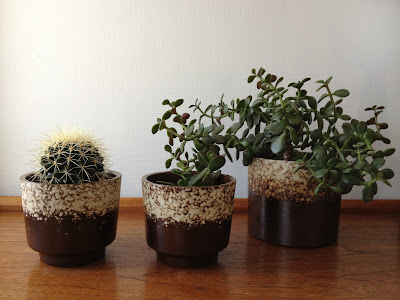I'm addicted to green plants and vintage planters. I adore succulents and cacti, and wish we had the climate to have them in the garden too. Sometimes my living room turns into a greenhouse, it's kinda like that now.... I thought I'd show you the vintage planters I've picked up during the last couple of years and the plants that reside in them at the moment. If you've been around for a while, you've probably seen several of them before.
I have a thing for traditional, rustic pottery. I've bought a few of the old Sandnes pottery from Gann and Graveren. Those are the household storage jars and baking bowls they produced before they employed artists and started to make more colorful and "designed" pottery. These are obviously not mid- century, they're all probably around a 100 years old. Consequently, they are not water proof anymore. I've put dishes under the plastic pots inside the storage jars, but I wondered a long time what to do with the bowl. I ended up buy simply placing a terracotta pot and saucer into it. The colors match so why not. Sometimes it's a planter, sometimes a fruit bowl. Below is a new little bowl (a local pottery, Pottemaker Simonsen, still makes them) and the traditional Sandnes flute in the shape of a bird. I've written several times about these, so I won't bore you with repeating everything. If you like, you can check out my previous posts about this pottery, here, here and here.
I have tons of terracotta pots, they look better and better with time. See what I mean by greenhouse? The Monstera (second from the left) is one of my favorites.
These next Scheurich fat lava planters I picked up in Stavanger, on the thrifting spree I had with my mum. There was a third one, I can't believe why on earth I didn't get that one too. I've paired them with a large Scheurich vase, which is really a floor vase, that picks up the caramel colored glaze. I have another very similar one too, with green glaze instead of the brown.
I love the glaze on these. To me, they look a bit more 70s than 60s, but I can't be sure. They "touch the ground" differently, the small ones with a base, the typical "german planter way", the largest one is straight all the way down. sadly the plant in the latter has died since this picture was taken.
More handsome germans, as we like to call them. these are among the first I got. Two of them are residing on my teak credenza. The third, the Bay that my little thrifter found for me, enjoys the companty of my newly thrifted Carstens in the kitchen window.
Finally, my wild child. It's ugly in a nice way. Or the other way around. Is it over the top or not? I can't decide...
This post is gonna be a long one, I can see where this is going... I thought I'd throw in the latest finds too, just to keep the winner of my giveaway in suspense:-) I stumbled upon a flea market yesterday in the driveway of a lovely lady. She told me she loved arranging flea markets, and had one every time her mum and aunt cleared out their cabinets. Her prices were ridiculously low, and I walked away, or drove off, rather, with this piece of danish studio pottery bowl marked "Ernst - handmade - Faxe - Denmark -
8-73" If you conoisseurs out there know more, I'd be interested! Sadly,
it's a bit chipped, but hey, it was only a ten'er (that's a dollar and a
half)!!
I got this one for about the same amount! Figgjo daisy skillet, by the amazing Turi Gramstad Oliver.
I also picked up these Egersund cups. They're the same design as Korulen and Unique (by Kaare Block Johansen) but have a different pattern, also very 70s. I've seen this pattern before, but don't know the name of it, anyone?
I found this beautiful teapot in a charity store. You all probably know this pattern, but if you don't, it's Stavangerflint Sera, design by Kåre Berven Fjeldsaa, decor by Inger Waage. Love the colors and the 60s graphics!
Found another souvenir plate, handpainted by Inger Waage. I've decided to buy only the Stavanger ones, but couldn't resist one from Kristiansand. It's a city my kids love, it's on the southern tip of Norway, a great vacation spot for families. There's a zoo and a theme park baked into one great child paradise. Mine have outgrown it years ago, but the sound of this city's name obviously rings some great sounding bells. And my plates are up on the kitchen wall now!! These things don't happen overnight with me...
Finally, I'll announce who will be the next owner of a Stavangerflint plate, handpainted by Inger Waage. With the help of some WG pottery, I drew the winner today, who is.....drumwhirl.....
That's Kylie of Lucy Violet Vintage!!! It will arrive in the mail shortly, Kylie!!



















































